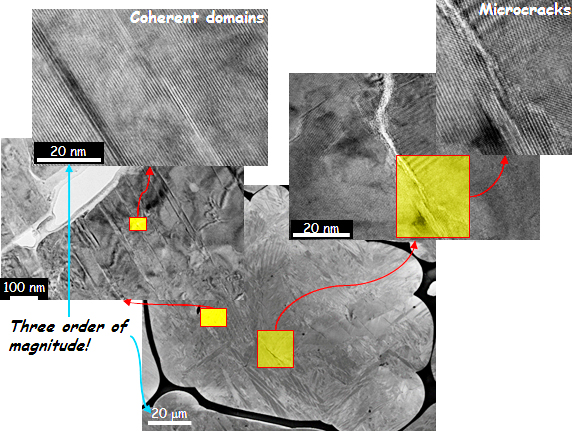
Illustration of mechanical behaviour of nanostructured oxides when exposed to very high temperatures
Source: HotMix Project
Project period
01/05/2020 - 30/09/2023
Project type
Collaborative research project
Project status
Closed
Description
The aim of the HoTMiX research project is to provide a deep understanding of the relationships between the nonlinear mechanical response of oxide materials at very high temperatures and their microstructure at the nanoscale.
Location
Bundesanstalt für Materialforschung und -prüfung
Unter den Eichen 87
12205 Berlin
Ceramic materials of three orders of magnitude Source: HoTMix Project
The global thermomechanical behaviour of polycrystalline ceramic materials cannot be predicted from the fundamental properties of corresponding crystals, nor can it be understood solely at the macroscale. Solid-state phase transitions and anisotropy of the thermal expansion simultaneously result into the appearance of nanosized crystals and of huge stresses, heterogeneously distributed among crystals. This can result in a multiscale and complex crack network at scales ranging between a few nm and a few mm. The aim is to provide a deep understanding of the relationships between the nonlinear macroscopic mechanical response of oxide materials at very high temperatures and their microstructure at the nanoscale.
Source: BAM
Combining plasticity at the microstructural scale with unconventional elastic behaviours related to size effects.
Some intrinsically brittle oxide materials exhibit an unexpected high compliance. Although this is observed at the microscale, its origin lies at the nanoscale. The understanding at the nanoscale of this mechanical behaviour is the central objective of the HoTMiX project.
Source: BAM
The relationship between microstructure and mechanical properties will be explored by combining two different approaches:
1) In situ measurements at very high temperatures or under applied stresses will be carried out using X-ray based advanced techniques at synchrotron radiation beamlines.
2) Accurate microstructural modelling will be developed, based on virtual microstructures undergoing temperature and external stresses evolutions.
Source: BAM
Project coordination
Institut de Recherche sur les Céramiques, Limoges
Partners
Procédés et Ingénierie en Mécanique et Matériaux, Paris
lnstitut de recherche interdisciplinaire de Grenoble
Institut Néel, Grenoble
Universität Ulm, Institut für Stochastik
Supporters
St-Gobain Research Provence and Safran Tech
Impact
The oxide compounds often crystallize under low symmetry, exhibit anisotropic elastic properties and are subject to a number of solid-state phase transitions as a function of temperature and pressure. As a result, generally speaking the global thermomechanical behaviours of polycrystalline ceramic materials cannot be predicted from the fundamental properties of corresponding crystals. Such global properties are indeed related to nanoscale characteristics, typically between 10 and 100 nm, lying between the crystal size and the ceramic grain size. Using up to date strongly cross-linked experimental approaches based on the use of synchrotron radiation sources and virtual material design methods, the HoTMiX project will get fundamental knowledge of the interplay between plastic and elastic strains at very high temperatures at this nanoscale into oxide based materials. The "virtual microstructure" approach will also enable a sort of high-throughput materials selection and design in the field of high-temperature materials, which is trivially impossible on an experimental basis. We expect that such an approach will have a deep impact on the scientific knowledge and could interest industrial partners as fundamental knowhow related to the materials they are fabricated or used.

HoTMiX brings together researchers belonging to very different research fields. The variety of these fields is illustrated in the word cloud.
Source: HoTMix Project
Technical work packages
HoTMiX will be organized as a 3-fold project. The first two workpackages concern quantitative microstructure analysis of two scientific cases. In the third workpackage, we will develop models for the generation of virtual microstructures that mimic real ones.
Size, shape, heterogeneity, cracks and microcracks in situ
The experiments will be based on X-ray diffraction, scattering and refraction. Due to the required spatial resolutions both in the direct and reciprocal space, we will carry out measurements on synchrotron radiation beamlines using a dedicated furnace. We will access to quantitative microstructural evolutions at temperatures as high as 1700 °C. Through such experiments, we probe a volume with edges of a few hundred micrometers corresponding to a large polycrystalline volume. The same furnace will be used for global strain measurements (workpackage 2) and will also be adapted to local X-ray diffraction experiments using polychromatic beam, i.e. the so-called “Laue microdiffraction” on the beamline BM32 at the ESRF (European Synchrotron Radiation Facility). High-temperature synchrotron X-ray computed tomography (SRCT) and X-ray refraction (XRR) measurements will be carried out.
Multi-scale stress and strain state in situ
The measurement of elastic strain in polycrystalline materials by X-ray diffraction can be performed either with a sub-millimetric monochromatic beam probing simultaneously a large number of crystals or by using a polychromatic microbeam (Laue microdiffraction) with a cross-section close to or smaller than the crystal size, scanning over a macroscopic region of interest. In the first case, the obtained values are statistically averaged over many crystals and thus directly representative of the material, while the second approach allows the determination of the full strain tensor of each crystal by means of a sample raster scan. Notably, in both cases the atomic displacement field and strain distribution are determined at a spatial resolution much lower than the crystal size. We propose to associate global measurements using a large monochromatic X-ray beam for a statistically averaged description of the microstructure and Laue microdiffraction measurements using highly focused polychromatic X-ray beam, which allows fast mapping of the local orientation and strain. Knowing the elastic constants and the measurements of the full strain tensor, local stress field heterogeneities over the microstructure can be determined. Using in situ mechanical tests, the stress distribution will be investigated for various applied stress levels, and data will be interpreted by means of a detailed comparison with the micromechanical modelling of workpackage 3.
Multi-scale modelling - Microstructure and mechanical properties
This work package is dedicated to the combination of stochastic 3D microstructure modeling with scale transition micromechanical modeling in order to quantify relationships between the materials’ microstructure and the corresponding mechanical response at all relevant scales. This requires to setup a model for the generation of a large set of virtual, but realistic, microstructures. A micromechanical model will then be used to solve for the stress/strain fields inside those microstructures, when submitted to thermo-mechanical loadings. A statistical analysis of the heterogeneous stress/strain fields will be performed for the sake of experimental comparisons.
Coordinators
Prof. René Guinebretière IRCER - Institut de Recherche sur les Céramiques, Limoges, France
Prof. Dr. Giovanni Bruno BAM - Bundesanstalt für Materialforschung und -prüfung , Berlin, Germany
Partner organisations
IRCER - Institut de Recherche sur les Céramiques, Limoges, France
PIMM - Procédés et Ingénierie en Mécanique et Matériaux, Paris, France
IRIG- lnstitut de recherche interdisciplinaire de Grenoble, France
Institut Nèel - Institut Néel, Grenoble, France
BAM - Bundesanstalt für Materialforschung und -prüfung, Berlin, Germany
UULM - Universität Ulm, Institut für Stochastik, Ulm, Germany
Supporters
St-Gobain Research Provence and Safran Tech, France
Job openings
Recruitment of a PhD student (m/f) - Thermomechanical properties of refractory materials, influence of the diffuse microcracking (PDF)
Host: CNRS in Limoges, France
Recruitment of a PhD student (m/f) - Microstructural analysis of oxide nanostructured materials through in situ high temperature X-ray scattering using synchrotron radiation (PDF)
Host: CNRS in Limoges, France
Recruitment of a Post Doc fellow (m/f) - Multiscale analysis of oxide nanostructured materials through in situ high temperature X-ray scattering using synchrotron radiation
Host: CEA-IRIG in Grenoble, France
Funding
HoTMiX receives funding through Agence Nationale de la Recherche (ANR) and Deutsche Forschungsgemeinschaft (DFG)

Source: ANR and DFG


